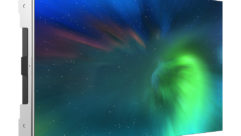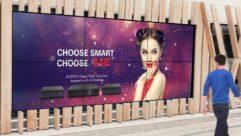Not a Projector, Not a Monitor, It’s a Videowall!
Jan 1, 2001 12:00 PM,
By Peter H. Putman, CTS
It seems like I’ve been writing about electronic displays for most of my life (particularly after one of my multiproduct projector or plasma reviews). Yet, my interest in large-screen images originated in the late 1970s with a process known as multi-image slide projection. Back then, video projectors were scarce, and direct-view monitors were strictly video-only beasts. For visual impact, multiple, dissolving 35mm slide projectors were the way to go, throwing images of all sizes and shapes onto screens with 2:3, 3:1 and even wider aspect ratios.
Slides were pretty much king of the hill until the mid-1980s, when the tide definitely turned in favor of electronic imaging. Leading the way was a new hybrid technology, one that borrowed the concepts of multiple images and blended it with faster imaging. This gadget—the videowall—allowed media producers to achieve the same effects as their slide shows had previously done, but without the film processing, glass mounting and tray loading of past years.
The impetus to use videowalls was fueled largely by a German manufacturer, Gundermann AG. These early walls were made from stacked, direct-view CRT video monitors, fed by tape and early laser disc players, and controlled by unbelievably complex circuitry. (Remember, everything was analog back then!) Other companies soon followed, most notably Pioneer, which introduced rear-projection CRT cubes to the arena; and Electrosonic and ICT, which pioneered sophisticated multi-image controllers. Stacks of slide projectors and fast-fold screens soon gave way to square, rectangular and even triangular arrays of videowall monitors as meeting producers and designers of entertainment venues and trade shows were quick to jump on this new, larger-than-life display technology.
The development of digital signal processing and higher-resolution projection cubes in the early ’90s provided another shot in the arm for videowalls, which were now facing their own competition in the form of high-brightness video and data projectors. Companies such as Toshiba, GVC, Sony and Seleco joined in the fray, showing lines of digitally controlled rear projection and direct-view data/video monitors. Videowalls became so popular that they had their own showcase at INFOCOMM—“The War of The Walls”—that ran from 1994 to 1996. The event was discontinued thereafter as videowalls settled comfortably into their niche as a specialty display for the retail, arena and transportation hub markets.
While the attention of the professional A/V market has largely shifted to flat-matrix front projectors and plasma display panels, videowalls haven’t stagnated. In fact, the introduction of such technologies as LCD and DLP imaging has given the videowall market another boost. It’s now possible to achieve both high-image resolution and high brightness in projection cubes, some-thing that wasn’t possible using older CRT technology.
WHY A WALL?
There are many ways to create large video and computer images, but one size doesn’t fit all. Front projectors can do a marvelous job of “in-your-face” imaging, but they require enough distance for the projection throw, and their screens must be shielded against stray ambient light, which reduces image contrast. Direct-view monitors are certainly bright but are limited in size and true resolution. No such limitations exist for flat-matrix rear-projection cubes. Because they are incident light devices, the images remain bright with high contrast even in high ambient lighting (which is why the retail and arena marketing channels love ’em). LCD and DLP projection cubes take up a lot less space than their older CRT counterparts, and their weight is considerably lower.
Digital image controllers are more powerful these days, and their prices have come way down. These controllers (and the projection cubes they drive) are also format-agnostic, so a variety of interlaced and progressive-scan signals can easily be mixed and displayed. The fast-growing plasma-display-panel market is making further cuts in weight and size possible, without sacrificing brightness, contrast or resolution. Right now, you can build videowalls with individual cubes capable of at least 1024×768-pixel (XGA) resolution, in screen sizes up to 67 inches. Those cubes can be stacked into squares, rectangles or just about any shape you wish, and you can smoothly blend everything from DV, Betacam SP, laserdiscs (yep, they’re still around), HDTV and RGB computer signals.
Designing and using a videowall is as simple as understanding additive resolution and aspect ratios. Here’s an example: Let’s say you project a 1024×768 image, using a conventional LCD or DLP front projector. Now, take a marker and divide the image into quadrants. Each quadrant will have a pixel count of 512 by 384 pixels, sufficient for showing video but not much more.
That might not look too crisp and sharp on a front-projected image measuring 10 feet in width, particularly when viewed from up close in a retail store. The distance needed to project an image that large will be substantial: typically from 12 to 15 feet without mirrors. The solution? Build a 3×3 videowall from 50-inch (diagonal) XGA projection cubes.
Each individual cube has as much resolution as the previously mentioned front-projected image. Adding the total available pixels results in a display capable of showing one 3,072×2,304-pixel image, or six individual 1,024×768 images. That’s a lotta pixels, more than enough for QXGA (2,048 by 1,536) and 1,920×1,080 HDTV.
As long as your wall design uses equal amounts of vertical and horizontal cubes, you’ll wind up with the same aspect ratio as any one cube. You can also come up with other aspect ratios—a 3-foot-high by 4-foot-wide wall yields a 16:9 aspect ratio image, which looks really cool with HD sources such as 720p and 1080i. Stacking two 4:3 monitors in a single vertical row yields a 2:3 aspect ratio, the same as 35mm slides.
Speaking of HDTV, there aren’t any front projectors currently available with 2K resolution; JVC’s QXGA D-ILA device (2048 by 1536 pixels) is still a year away. No problem! Design a 3×4 cube, 16:9 wall using nothing more than 800×600-pixel projection cubes. The total pixel count for such an array would be 3200 by 1800, which works out to 40% more pixels than those in a 1080i signal.
TURNABOUT IS FAIR PLAY
The introduction and widespread acceptance of plasma display panels have many creative types wondering how well they’d function in videowalls. Could PDPs push LCD and DLP projection cubes off the videowall map, just as LCD/DLP technology has largely relegated CRT projection cubes to the back burner? Not likely.
There are several limitations to plasma panels that must first be overcome, not the least of which are the thick frames surrounding the plasma glass arrays. These frames are thick for a reason: They provide structural reinforcement to the fragile PDP glass and also carry cooling air around the panel. (PDPs get quite warm during normal operation.)
Thick mullions (divider frames) were the hallmark of early videowall monitor cubes, which led to a problem when someone’s face was centered on a 4×4, 6×6 or 9×9 wall. The problem was solved (more or less) when projection cubes became popular. Pioneer, in particular, developed extremely thin mullions for their RP cubes and showed a prototype “mullion-free” RP cube a few years back.
Thin mullions—and cubes with essentially no mullions—are easy to implement with DLP and LCD technology, as the frame is solely a structural element. It will take some real head-scratching and clever engineering to come up with a thin frame for a PDP that doesn’t compromise cooling and rigidity issues!
Even so, Pioneer has already shown “concept” videowalls made from their 40-inch 4:3 panels, and NEC recently introduced the 42MP1 panel with a built-in image multiplexer. It lets you connect up to four panels and zoom images across all of them, creating a 16:9 84-inch diagonal plasma videowall. Of course, there are those thick frames to contend with again.
Given the increasing demand for plasma, I think we’ll see more PDP “cubes” brought to market in 2001, with special signal processing electronics such as NEC has adopted. There’s just too much potential for large direct-view displays that would require less than a 6-inch footprint. Add in the wide (160 degrees horizontal and vertical) viewing angles of PDPs, and you’ve got a winner.
WHAT’S NEW?
Since the tidal wave of single-chip DLP engines rolled through the videowall industry last year, most of the new product developments have occurred in signal processing. Even so, there are still some new faces and displays. Mitsubishi Digital Electronics introduced the first 1024×768 DLP cube a year ago and now offers the MegaView Wall based on 50-inch 4:3 projection cubes with 0.7-inch 1024×768 DMDs. It supports both analog RGB and DVI inputs and has a 26-inch footprint.
Pioneer New Media Technologies continues to innovate their CRT projection cubes with the new RM-V2550S2, a thin-mullion (1 mm) videowall projector that creates a 50-inch diagonal image, yet is only 29.5 inches in depth. One RM-V2550S2 is required for each projector, and the completed videowall mullions are almost invisible. Unlike standard cube screens, the RM-V2550S2 is comprised of material that reduces distention caused by heat and humidity. By minimizing this expansion and contraction, the screen can be held by a slimmer mullion since it maintains a more consistent shape.
Imtech, a Denville, New Jersey-based videowall and datawall systems integrator, recently released the latest version of its Activu IP-based datawall processor and controller. Imtech has been targeting the financial display markets and made a big splash a few years back with the 100-monitor NASDAQ Marketwall. The company has since integrated displays for J.P. Morgan in New York, American Airlines in Tulsa, Oklahoma, Metro Media Fiber Network NOC and the Cairo Stock Exchange.
“Historically, we’ve been a manufacturer of traditional hardware-based display processors,” said Paul Noble, CEO of Imtech. “Today our ‘processing’ is 100% network software-based, using standard off-the-shelf brand-name NT servers such as IBM e-Servers. Custom hardware development in a market as relatively small as ours is enormously [inefficient]. Instead, our software-based solutions, using Activu software, deliver infinitely greater performance and versatility at a far lower cost and leverage off IBM’s enormous economies of engineering and manufacturing scale, as well as their incredible support networks.”
Clarity Visual Systems is also making inroads with its Advanced Performance LCD projection cubes into command and control, retail and financial markets. Their new Lion display is the industry’s ½rst 67-inch SXGA (1280×1024) rear projection Advanced Performance LCD projection cube and was designed for a wide range of applications in business and institutional command and control and data visualization.
Lawrence Livermore Laboratories in California recently installed eight Lion units, with six of them used to create a 2-foot-high by three-foot-wide conference-room videowall for viewing modeled computer data. The remaining two units will be used as stand-alone displays.
“We’ve been seeing a lot of interest in videowalls, but we prefer to use the term ‘visual messaging,’” said Ed Kiyoi, product manager at Clarity. “Demand is increasing for business-to-business visual communications applications like command and control centers. This growth is being fueled by the increase in Internet activity. Our datawall displays function much like those used by the military and public utilities—they’re de½nitely ‘mission critical.’”
Videowalls aren’t limited to stationary applications. Adstruck TV of Burnsville, Minnesota, has launched an innovative concept in consumer advertising, running a mobile advertising truck around the Minneapolis-St. Paul area four nights a week, four hours per night, displaying advertisements on three 60×80 videowalls, creating three mobile 100-inch diagonal full-motion video billboards. Their route takes them to all of the major shopping areas in the Twin Cities metro area, as well as downtown Minneapolis and St. Paul. The truck also has a built-in sound system for audio support when parked at special events.
Electrosonic Systems of Minneapolis assisted with the design and was responsible for the videowall installation, which consists of twelve Pioneer RM-V2550 50-inch projection cubes. An Electrosonic ImageStar processor provides the video processing to the three 2×2 walls via an Electrosonic RGBS Distribution amplifier. The system uses a computer hard drive and an S-VHS deck for sources.
While the majority of videowalls are built from tube or solid-state projection cubes, there are alternatives. One in particular involves the use of light emitting diodes (LEDs) arrayed in matrices. The advantage of LED displays is their extreme light intensity, which is perfect for areas with high ambient light. Of course, you need to stand back some distance from a LED “wall” to minimize the size of the resulting pixels.
SACO Smartvision is in the process of installing several LED outdoor displays in Milan, Florence and Rome that measure 18 square feet. These displays are essentially dynamic billboards, used to flash video advertising and text messages to passing drivers and pedestrians. Both 15mm and 10mm LED arrays are used in these displays. SACO also designed and installed the NASDAQ Marketsite Tower in Times Square, New York, which, at 120 feet tall by 90 feet wide, is the largest LED display in the world.
General Video Corporation recently announced a small, transportable LED grid display known as LED-net. It uses lightweight metal rigging and a unique plastic trellis to hold LED matrices, which creates the illusion of transparency when the display is not active. The advantage of this system is that the “cubes” can conform to unusual shapes, or be wrapped around objects much like a cloth.
DOWN THE ROAD
The market for “tiled electronic displays” has changed so much that the term “videowall” has fallen out of favor with some manufacturers. Because of the higher resolution afforded by flat-matrix imaging, a more appropriate term for these displays would be “datawalls.” Indeed; even the lowest-resolution projection cubes can still handle VGA (640×480) progressive-scan sources. In many cases, the lowest resolution cubes are SVGA (800×600)—a 2×2 stack of those can easily accommodate UXGA (1,600×1,200) graphics.
Imtech’s migration to IP network control (and away from custom hardware) is definitely the future trend for all manufacturers of electronic displays. It’s a pragmatic decision, as hard disk storage and digital signal processing chips are commodity items. By adopting off-the-shelf server and storage technology, manufacturers can take advantage of inexpensive hardware and software upgrades, all while using standard GUI systems.
LEDs are making serious inroads into the outdoor wall market, particularly due to their resistance to the elements and high brightness levels. Assuming smaller pixel arrays can be designed (thereby increasing resolution), LED cubes may be a practical alternative to smaller, indoor, tiled displays.
The wild card is plasma. If manufacturers are successful in reducing the size of plasma frames without sacrificing cooling and structural integrity, PDPs may gain a big leg up on the market. Otherwise, expect traditional LCD and DLP projection cubes to dominate indoor videowalls and datawalls for some time to come.










